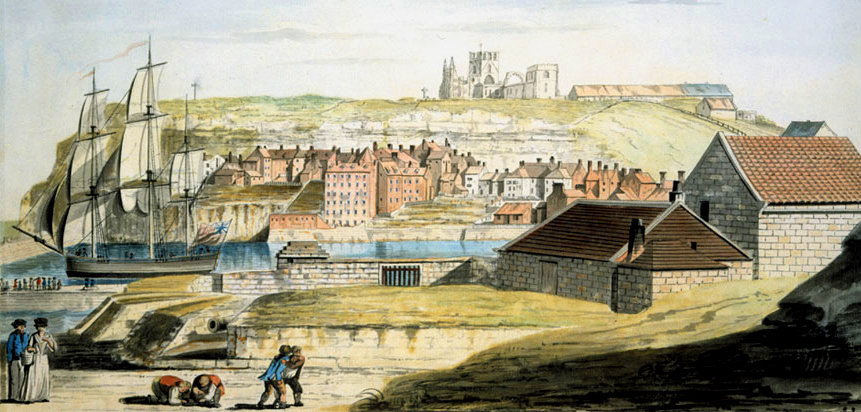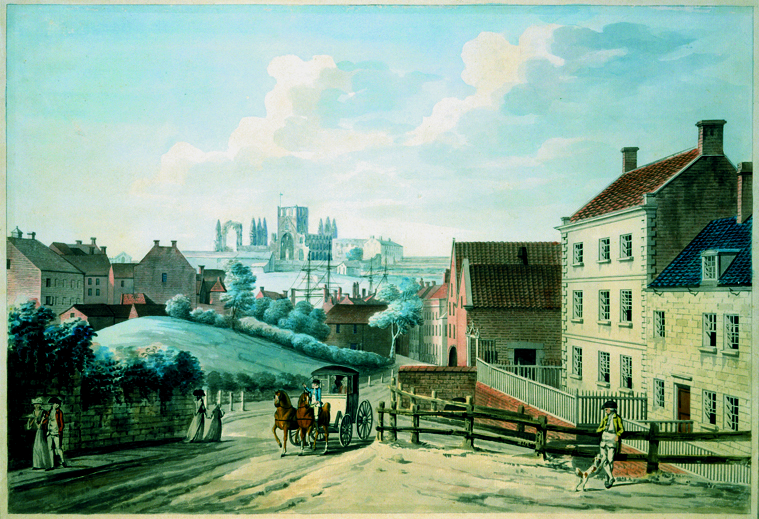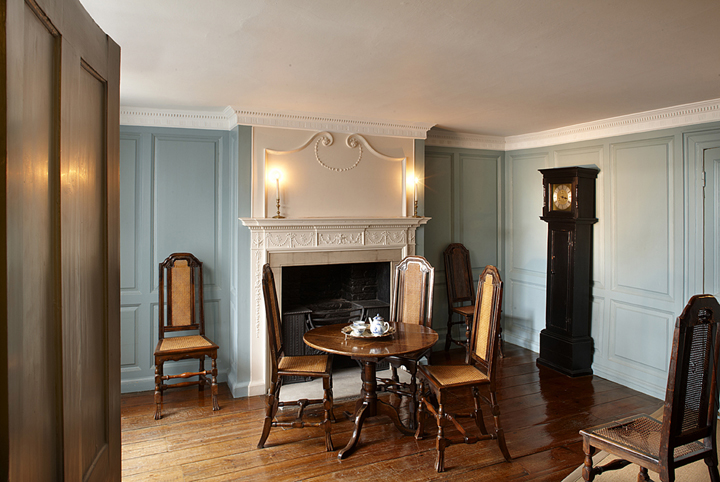
Whitby (1746-1755)
WHITBY DURING THE YOUNG JAMES COOK’S EARLY MARITIME CAREER
By Sophie Forgan, Trustee Chairperson Captain Cook Memorial Museum, Whitby
Cook spent nine years in Whitby, three as apprentice and six working his way up Captain Walker’s shipping service. These years had a profound influence on his later life and career.
What was the town like in the mid-18th century, what were the ships on which he learned to sail, and what training did he receive?
Whitby in the mid-18th century was much more important than might be imagined today – it was a centre of shipbuilding, highly prosperous, and the nexus of the coal-carrying trade between Newcastle and London. It was in fact the sixth biggest ship-building port in the country outside London. There were many shipyards, mostly on the banks of the river Esk, several dry-docks, three ropewalks for manufacturing the cordage needed for ships, sail-making lofts, and even sailcloth manufactories (from 1756). It was a place teeming with highly skilled craftsmen. These were not just little fishing boats being built, but tough, capacious collier barks, sometimes called cat-built barks, or simply ‘cats’, though the term was not in contemporary use in the town itself.

Whitby, North Yorkshire after Joseph William Turner, 1826
Collier barks were square-rigged, three-masted ships. They were designed to transport coal on its journey from the coalfields of northern England south to London. They also traded across the Baltic, bringing back timber, tar, hemp and other naval supplies. They were not elegant or particularly fast, but very capacious in order to carry low-value, bulky goods such as coal, and very reliable and durable. As they were virtually flat-bottomed, they could be beached anywhere. No quay or dock was needed. There were between 250-300 ships owned by Whitby men sailing out of the port – far too many to fit in to the harbour altogether at once. Many over-wintered to the north in Newcastle or Sunderland. The ships were well known to the Royal Navy, and frequently hired as troop transports or supply ships in times of war. For example, a large number of collier barks were used during the Seven Years War in North America.
So Whitby was a bustling port with lots of opportunity for work. It also had a strong Quaker community which was very influential in the town. The Society of Friends, or Quakers, believed in moderation in all things, in not bearing arms and abstaining from violence. The latter was sometimes tested in encounters with pirates who knew that Quaker owners almost always ransomed crews who were captured! But their belief in hard work, lack of ostentation, self-improvement and professional education contributed to an ethos which characterised dealings in a shipping community where most people knew each other.
So it was not perhaps surprising that Whitby was a place which had gained a reputation for training young men for the sea. Boys came not only from the surrounding countryside, but also from places much further away, even as far as the Orkneys. The town must have been awash with boys and young men. From 1747-48 (the same year that Cook was an apprentice) there were over 1200 apprentices listed in Whitby’s ship muster rolls, and this in a town of some 5000 inhabitants. What an impact that must have had!
There were reasons why training in Whitby was highly regarded, and the first is perhaps a rather surprising one. There was no publicly endowed or grammar school in Whitby. In many places after the Dissolution of the Monasteries, some of the proceeds went into endowing a grammar school. Not so in Whitby. In consequence there was no accepted model of a standard classical education for the sons of prosperous burgesses – boys did not have to learn Latin or study Roman models of behaviour. By contrast, there were commercially-oriented schools and the teaching of mathematics was encouraged because of its practical use at sea. It was here that Cook acquired the mathematical knowledge which enabled him to develop navigational, cartographic and astronomical skills of a high order.

Furthermore, Quakers believed that education should be practical and professional. They ploughed their money back into the business, helping to make them some of the most prosperous in the mercantile community. Everyone of course knew each other, met in the regular religious and social gatherings, and took in each other’s sons as apprentices. It follows that a large measure of tacit social control was exerted. If a captain was harsh and treated his crews or his apprentices badly, everyone would soon know and the word would spread. The harsh master might find it difficult to get reasonable apprentices and, if a Quaker, might be thrown out of the fellowship until he repented and promised to mend his ways. The result was that training was tough, the sea was always a tough place to work, but people were generally well treated, well fed and well trained. It is a remarkable fact that over the century and more for which records survive, there were few deserters from Whitby ships and crews showed remarkable stability, at a time when desertion from ships was extremely common.
So the young Cook came to a place which had a high reputation for professional training, for relevant learning and knowledge, and where there was a tradition of hard work but care for crews. And he was well trained – in pilotage, navigation, relevant mathematics, and ‘mercantile accompts’. Shipping cargoes from one place to another meant keeping tight control over stock and cash, and Cook would also have been familiar with provisioning. As an apprentice he would have been sent into town at the various ports to stock up with fresh food and buy supplies for the ship. It is not too much to suggest that Cook’s emphasis on diet and cleanliness was a regime learnt in the lightly manned ships of Whitby, where it was essential to provide sufficient good food to sustain a great deal of hard physical labour managing the ship, especially when fully laden with coal. A collier typically had a crew of between 20 and 25, of whom half might be boys. Endeavour by contrast had a approved complement of 85 men.
Finally, the young Cook was encouraged to better himself, to aspire to the sort of comfortable prosperity visible in his master’s Whitby house. This unostentatious prosperity and care for lasting good quality things may still be seen in the surviving rooms of Walker’s house, furnished today according to a surviving inventory from the early 1750s. The pleasing simplicity and elegance comes from the skilled craftsmanship visible in the fabric of the house. The rooms had slightly old-fashioned furniture built to last. The story goes that the housekeeper saved Cook candle ends so that he could study books in the evening while the other apprentices occupied themselves with ‘trifling amusements’. Whitby was therefore an aspirational place, where men had been going to sea for hundreds of years, where their skills were honed through generations, where they were part of a close-knit community but one which also looked outward to the rest of the world.
As the early 19th century Whitby historian, George Young, commented: “Our seamen have long been distinguished by their courage, activity, skill and experience”. This was where good sturdy ships were built. Thorough training was given to the young men who chose the sea for their livelihood, and an ethos of straight dealing, plain words, and hard work characterised the community of shipowners and master-mariners. It is not surprising that the Royal Navy welcomed the well-trained and experienced master’s mate into their service. It is also not surprising that Cook remained friendly with the man to whom he had been apprenticed, Captain John Walker, and corresponded with him the rest of his life.

Learn more about Cook in Whitby by visiting the Captain Cook Memorial Museum.

Note: The information on the Whitby fleet at this time uses the work of the late Rosalin Barker, The Rise of an Early Modern Shipping Industry: Whitby’s Golden Fleet, 1600-1750, (2011, Boydell Press).
